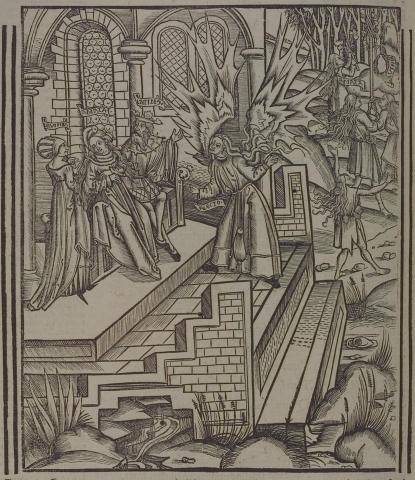Annotations
Allecto, with snakes for hair and wings that appear to be made of fire, stands in the center of the image in front of Amata (341-4), who sits next to Latinus in the palace, while Lavinia stands next to them. Though Allecto is visible to the audience, she is invisible to the mortals in the image. A serpent, one of Allecto's, has curled itself around Amata's neck (345-53). Amata and Latinus both look at Lavinia, to indicate that they are discussing her. Amata pleads with her huband to marry Lavinia to Turnus instead of Aeneas (354-72). In the upper right corner, Amata feigns a Bacchic frenzy and brings Lavinia to the forest to hide her there (385-7). Two other matrons join in the Bacchic frenzy with Amata; one ties up her skirt, while the other holds what is probably supposed to be a thyrsus, a staff wrapped with ivy and vine-leaves and associated with Bacchus (392-6). Amata also carries a thyrsus, though in the text, she holds a blazing pine branch or torch (397-8). (Katy Purington)
Woodcut illustration from the “Strasbourg Vergil,” edited by Sebastian Brant: Publii Virgilii Maronis Opera cum quinque vulgatis commentariis expolitissimisque figuris atque imaginibus nuper per Sebastianum Brant superadditis (Strasbourg: Johannis Grieninger, 1502), fol. 297v, executed by an anonymous engraver under the direction of Brant.


Sebastian Brant (1458-1521) was a humanist scholar of many competencies. Trained in classics and law at the University of Basel, Brant later lectured in jurisprudence there and practiced law in his native city of Strasbourg. While his satirical poem Das Narrenschiff won him considerable standing as a writer, his role in the transmission of Virgil to the Renaissance was at least as important. In 1502 he and Strasbourg printer Johannes Grüninger produced a major edition of Virgil’s works, along with Donatus’ Life and the commentaries of Servius, Landino, and Calderini, with more than two hundred woodcut illustrations. (Annabel Patterson)